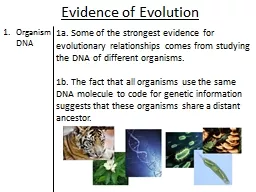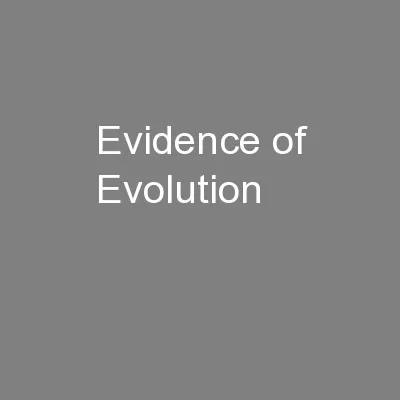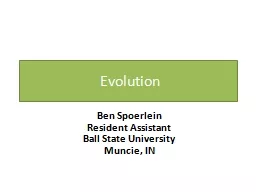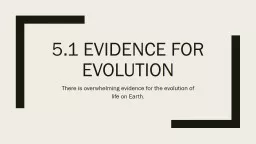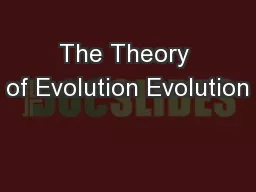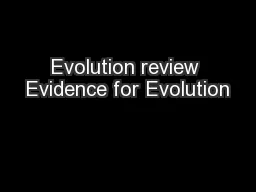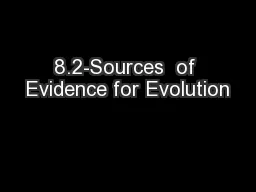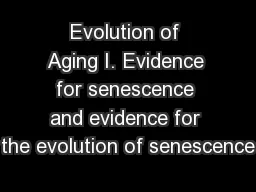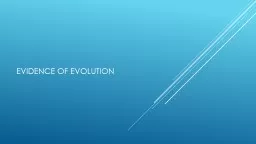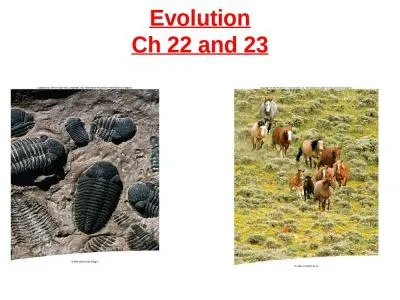PPT-Evidence of Evolution
Author : liane-varnes | Published Date : 2017-08-06
Organism DNA 1a Some of the strongest evidence for evolutionary relationships comes from studying the DNA of different organisms 1b The fact that all organisms use
Presentation Embed Code
Download Presentation
Download Presentation The PPT/PDF document "Evidence of Evolution" is the property of its rightful owner. Permission is granted to download and print the materials on this website for personal, non-commercial use only, and to display it on your personal computer provided you do not modify the materials and that you retain all copyright notices contained in the materials. By downloading content from our website, you accept the terms of this agreement.
Evidence of Evolution: Transcript
Organism DNA 1a Some of the strongest evidence for evolutionary relationships comes from studying the DNA of different organisms 1b The fact that all organisms use the same DNA molecule to code for genetic information suggests that these organisms share a distant ancestor. Variation in Living Things. SPECIES - Group of organisms that interbreed. VARIATION - small differences between individuals of a species . Some neither helpful nor harmful . Some enable organism to be better suited to its environment.. EQ: What evidence convinced Darwin that species could change over time?. TEK 7ACDE. (. Supported . by 5 branches of . science. ). Evidence of Evolution. The Fossil Record (Paleontology). Geographic Distribution of Living Things (Geography). Evidence for Evolution. What is Evolution??. Change in the genetic composition of a population during successive generations, as a result of natural selection acting on the genetic variation among individuals, and resulting in the development of new species.. Ben Spoerlein. Resident Assistant. Ball State University. Muncie, IN. Charles Darwin. (February 12. th. , 1809 – April 19. th. , 1882). Credited with providing the first convincing evidence for the theory of evolution in his immortal work, . There is overwhelming evidence for the evolution of life on Earth. . Evolution in summary. Evolution occurs when heritable characteristics of a species change. . Evolution at its most fundamental level simply describes a . A mechanism for change in populations.. Any change in the . inherited . traits within a population across generations. Individuals better adapted to their environment tend to survive and . produce more offspring. What do we use in order to determine evolutionary relationships?. Fossil Record. Anatomical Evidence. Molecular Evidence. Embryological Evidence. Evidence for Evolution. Fossil Record. Evidence for Evolution. SBI3U1. Evidence. for . Evolution. The theory of evolution by natural selection was proven by the following methods: . Fossil . Record. Biogeography. Anatomy. Embryology. DNA. Fossils are found within the layers of sedimentary rock. . . . FaithFromEvidence.org. Apologetics. Introduction to . FAITH from Evidence . . Evidence for God part 2 (11-22). The Problem of Evil (11-29). The Bible and Science (12-06). Creation (12-13). Evolution (12-20). The Genesis Flood (12-27). Archeology (01-03). Historical Jesus (01-10). Artificial selection increases life span in fruit flies. Inherent limits, or can lifespan evolve?. Fruit fly expt:. Female sockeye salmon defending its nest before dying. II. Fundamental Trade-offs. Mite Kiwi bird. is the process of change over time.. Evidence of evolution. . Biogeography. is the study of where organisms live now and where their ancestors lived in the past.. Patterns in the distribution of living and fossil species tell us how modern organisms evolved from their ancestors.. Early scientists proposed ideas about evolution. . Evolution is the biological change process by which descendants come to differ from their ancestors.. A species is a group of organisms that can reproduce and have fertile offspring.. . The process by which organism change over time. Based on science, not opinion.. Darwin. :. Evolution is descent with modification. Evolution. :. changes through time. Species accumulate difference.
Download Document
Here is the link to download the presentation.
"Evidence of Evolution"The content belongs to its owner. You may download and print it for personal use, without modification, and keep all copyright notices. By downloading, you agree to these terms.
Related Documents

